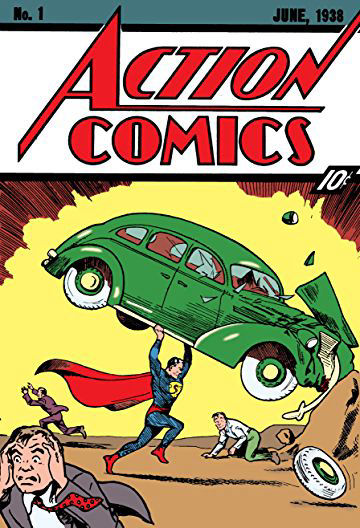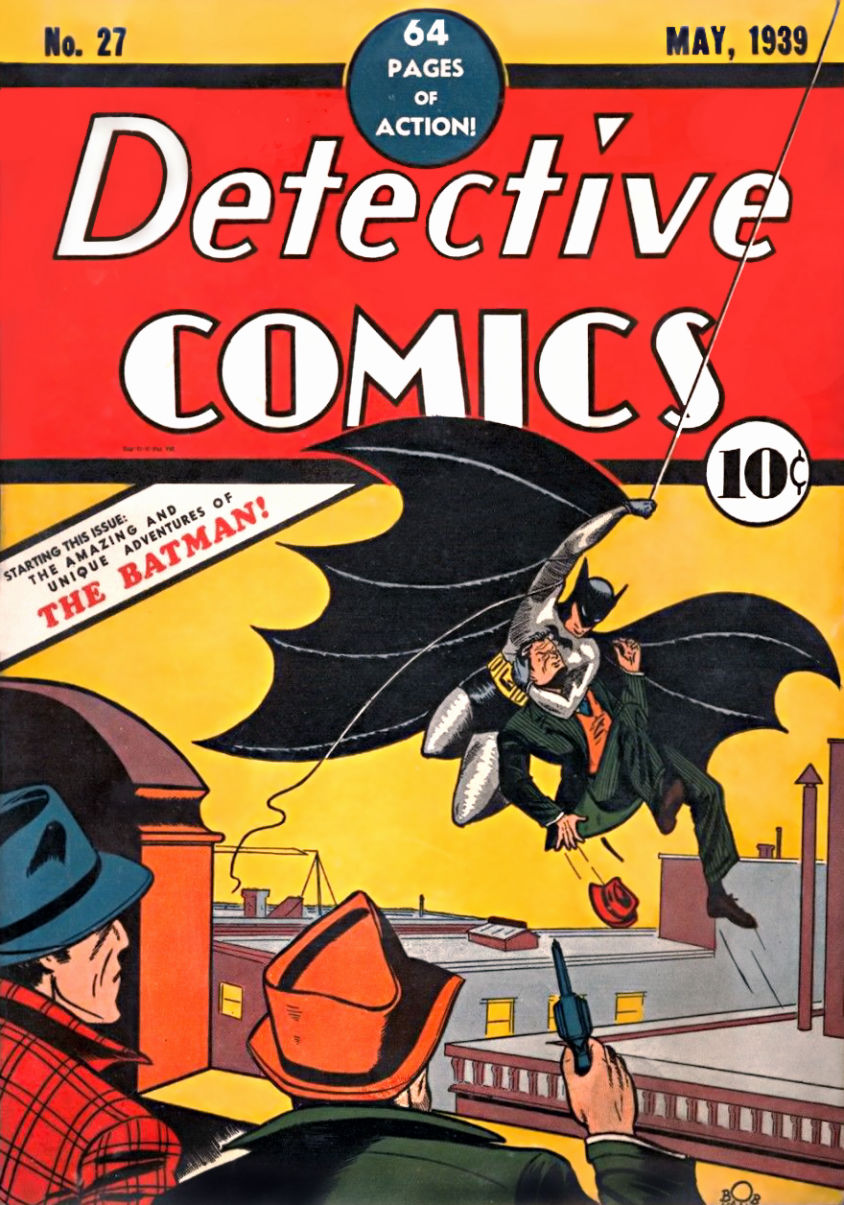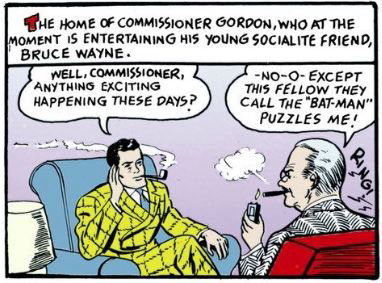
1938 is a bumper year for Robin Hood fans and scholars. In May of that year, audiences lined up to see The Adventures of Robin Hood starring Errol Flynn – a film which remains a treasured classic. But an even more momentous pop culture event happened in 1938. While kids were waiting in line to see Flynn’s swashbuckling masterpiece, they may have also been enjoying an art form both older and more recent than the movies – comic books. Some of those kids may have rolled up their comics and stuck them in their back pocket, or bent back the pages as they traded one of their comics for another their friends had. Little did they know that they were destroying a million dollar investment. And I’m just talking about what a mint condition copy is worth at auction. The cultural heritage of their flimsy paper treasures was far greater. These kids weren’t just holding a comic book. They were holding THE comic book – Action Comics #1.
While some historians have dated comic-style art back to cave paintings and Egyptian hieroglyphs, the modern comic book as we’d know them first appeared in the 1930s. As Gerard Jones wrote in his masterful history of the comic book industry Men of Tomorrow: Geeks, Gangsters and the Birth of the Comic Book “Now something had come along that adults and older siblings didn’t know about, something cheap and colorful and exotic.”
Back in the early days, comics were largely anthologies – each issue containing several distinct features. It was a holdover from their beginnings as reprints of popular newspaper strips . The first comic to feature new material – appropriately titled New Fun for its early issues, and then later retitled More Fun Comics – had over a dozen features including the Texas Ranger Jack Woods, Sandra of the Secret Service, the playboy adventurer Barry O’Neill. There was even a serialized adaptation of Sir Walter Scott’s Ivanhoe. The same publisher released other titles including New Adventure Comics (which in 1938 ran a Robin Hood serial) and Detective Comics. I say “the publisher” because they went under a variety of names (sometimes simultaneously) over the years, but it was Detective Comics that inspired their best known name – DC Comics. [The DC logo started appearing on their comics in 1940 although DC Comics did not become the company’s official name until 1977. I hope you’ll forgive the anachronistic use of it to avoid switching company names as the decades roll on.]

Like its predcessors, Action Comics #1 had several features. But in this case, it was the cover feature that captivated readers. A man dressed in blue tights and a red cape is holding a car in his bare hands above his head and smashing the vehicle as people flee in terror. Action Comics #1 was not only the beginning of a new comic book series. Not only was it the first appearance of a new character. It was the birth of a new genre – the superhero. Of course, the character on the cover is Superman. (You might notice the cover has a date “June, 1938”. That’s because dates on comics were not a release date but a sell-by date – a guide of when to take comics off the stands. Legal documents suggest that Superman’s first appearance went on sale on April 18, 1938.)
It took a few issues to figure out that the feature kids loved best was Superman, created by Jerry Siegel and Joe Shuster. When DC figured out what was driving sales they spun Superman into his own solo, self-titled comic book series in 1939. And the suits at DC and rival publishers wanted their own superheroes to cash in on the trend. The publisher also put costumed heroes into their existing anthology comics. A semi-superhero, the masked and trenchcoat-wearing Crimson Avenger premiered in Detective Comics #20, but he was little more than a rip-off of popular radio hero the Green Hornet. The Crimson Avenger feature lasted for many years, but he was no Superman. So DC looked elsewhere to spice up their flagship title Detective Comics.

DC turned to young Bob Kane to supply another superhero. Kane came up with a hero clad in red with large mechanical wings -- the Bird-Man. Fortunately, Kane ran the idea past his writer friend Bill Finger who suggested some major alterations. On the cover of Detective Comics #27, (May 1939) the Batman (or Bat-Man, as it was spelled in inside the comic for the first couple issues) swung into action for the first time. Like Superman, the Batman worn a skin-tight costume, but thanks to Finger's suggestions it was the more mysterious colours of grey and black (or blue as the highlights on the black became more dominant). Kane had originally wanted his character to have a small "domino" mask around his eyes, like the kind that Lone Ranger had. Instead, as Finger suggested, the Batman have a cowl with large bat-like ears.
Kane, Finger and others refined the character over the course of the year. A young 17-year old Columbia University student named Jerry Robinson was brought on to help out, and the art improved dramatically as a result. Finger (or possibly guest writer Gardner Fox) scripted an origin for the Batman to appear in issue 33. Fifteen years earlier, Thomas Wayne, his wife and their son were walking home from a movie when a gunman appeared and attempted to rob them. Thomas and Martha Wayne were shot dead. Their grieving son Bruce Wayne made a vow by candlelight "And I swear by the spirits of my parents to avenge their deaths by spending the rest of my life warring on all criminals." Bruce grew up to be a "master scientist" and "trains his body to physical perfection". He was inspired by a bat to adopt a disguise that would strike fear into the hearts of criminals.
It was a popular feature -- Batman held the Detective Comics cover spot on issues 27, 29, 31, 33 and from issue 35 onwards no other feature would challenge him. Batman also started to gather a bizarre group of foes. Issue 37 promised in the following issue that Batman would fight "huge, terrifying man-monsters". But that story was delayed a month, to become one of four stories in Batman #1 (Spring 1940), the second comic book series dedicated to a single superhero. But before Batman broke free of the anthology comics, a new character was added to the strip in Detective Comics #38 (cover dated April 1940) -- that character is the reason for this article. He was Robin the Boy Wonder.

Sources differ on whether it was Bob Kane or Bill Finger who first decided to give Batman a sidekick. If the idea did originate with Kane, then Finger at least saw the possibilities. As quoted in Batman: The Complete History by Les Daniels, Finger said "The thing that bothered me was that Batman didn't have anyone to talk to."
His alter ego Bruce Wayne had a fiancee -- Julie Madison -- who made occasional appearances in the early years, but she wasn't privy to his secret life. And Wayne would find out about criminal cases from his friend Police Commissioner James Gordon, but Gordon wasn't the clever and dependable ally of Batman that he became in later decades. Instead the early version of the Commissioner was if anything dumber and less helpful than the Scotland Yard detectives that Sherlock Holmes endured. What Batman needed was a Doctor Watson. The closest Watson analogue Alfred the Butler wasn't introduced until 1943, but there were other models for a sidekick to draw from.
Most of the heroes that inspired the comic book superheroes had people to talk to. These allies often came in two forms.
There were the gangs -- the Merry Men model that gave rise to pulp novel hero Doc Savage's "Fabulous Five" or radio and pulp star The Shadow's agents . Even the granddaddy of superheroes, the Scarlet Pimpernel, had the League of the Scarlet Pimpernel in Baroness Orczy’s 1905 novel (based on her earlier play) that helped set the superhero template.
Then there was the sidekick who was a representative of the other, often a different race from the hero. That tradition goes back to Gilgamesh and Enkidu, but really solidified as part of American culture with James Fenimore Cooper's immortal creations of Natty Bumppo and his Mohican ally Chingachgook. Radio hero The Lone Ranger had his own Indian companion Tonto, and the Lone Ranger’s fellow radio hero (and grand-nephew) The Green Hornet had the Japanese-Filipino sidekick Kato. In comic strips, Mandrake the Magician was accompanied by the African prince Lothar. More recently, this tradition continued with Kirk and Spock in Star Trek, and Robin Hood and Azeem in Robin Hood -- Prince of Thieves.
But Bob Kane, Bill Finger and Jerry Robinson didn't go either of those routes. Instead they gave Batman a kid sidekick. Of course, the kid sidekick is not completely without precedent. Stories of youthful heroes and their older mentors have been around since the days of Telemachus and ... well, Mentor (the character whose form the goddess Athena assumed to help guide Odysseus’s son in his travels in Homer’s epic poem The Odyssey – the source of the modern word mentor). Sherlock Holmes was occasionally assisted by Wiggins and the Baker Street Irregulars. Rudyard Kipling's young hero Kim had adult allies. In comic strips child hero Little Orphan Annie had her Daddy Warbucks. But both Kim and Annie were the stars with the adults as supporting cast.
There were other characters in comics who had kid sidekicks. Buck Rogers counted young Buddy Deering among his friends (or Buddy Wade, as he was in the popular 1939 movie serial). But it was far from the norm in comics... until Batman. However, the most obvious comic strip antecedent for Batman’s kid sidekick is The Kid aka Dick Tracy, Jr or most commonly Junior Tracy – the young street urchin that the eponymous Dick Tracy adopted in Chester Gould’s comic strips during the 1930s.
Then again, Sheldon Moldoff who briefly provided uncredited assistance to Bob Kane in 1939 (and who would return in the 1950s and 1960s as Bob Kane’s main Batman ghost artist) once said he mentioned in passing to Bob Kane he was going to create a kid superhero for a project of his own, but before that could happen Kane and his other collaborators introduced their kid sidekick, Robin the Boy Wonder, into the Batman comic. (Trying to assess the accounts of who created what in the comics ascribed to Bob Kane is a bit like the classic Japanese film Rashomon – after hearing different tales that cannot possibly fit together you’re left wondering not only what the truth of the matter is – but even if there is such a thing as truth.)
Clearly the idea of kid superheroes caught on. A couple months later rival publisher Quality Comics had introduced a new kid hero called Wonder Boy. Existing superheroes such as the Human Torch, the Shield, the Wizard and the Sandman acquired kid sidekicks. When new heroes such as Mr. Scarlet, Captain America and Green Arrow debuted, they had kid sidekicks too.
But why was the “original boy wonder” called Robin? Well, that answer to that is also why this article appears on a website devoted to the Robin Hood legend. You can read more about that in the next part.
NEXT:
PART 2 -What's In A Name? Robin and Robin Hood
PART 3 - Early Adventures (including Robin's origin)
PART 4 - Batman and Robin meet Robin Hood in The Rescue of Robin Hood (Detective Comics #116)
PART 5: The Caped Crusaders in 1950s and 1960s Comic Books and Television
PART 6 - Batman and Robin Meet the Archer (1966 TV episodes)
PART 7 - Robin Leaves the Nest (1969 - 1975)
PART 8 - The Dynamite Duo and Goodbye, Hudson University (1975 - 1980)
PART 9 - Robin No More: The Birth of Nightwing (1980 - 1984)
Contact Us